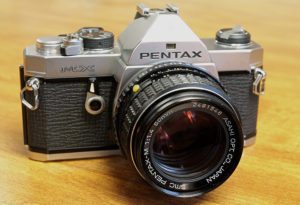Reflecting on my history as an amateur photographer
Recently I’ve been reflecting on my history as an amateur photographer. I spent 1982-3 as a high school exchange student in Austria (for you German speakers, I really lived in a village called Großklein). Before I left, I decided that I wanted to buy myself a good camera. A friend had a Canon AE-1, which was the consumer-grade pinnacle of SLR technology at the time with shutter-priority auto-exposure. My dad, however, asked a professional photographer for camera buying advice, and he recommended a Pentax MX SLR camera. The only technology on the MX was a built-in light meter. As you manipulated shutter speed and aperture size, a row of LEDs along the bottom of the viewfinder indicated whether the light level was good (red – yellow – green – yellow – red).
Film photography had two big constraints that are unknown to digital photographers. The first is delayed gratification; you don’t get to see your photo until after the film is developed and printed–which was a matter of days at the very least (hence the eventual popularity of same-day photo processing). The other limitation was cost; there were three separate expenses related to film photography: the film itself, and the costs of developing the film and printing photos.
The constraints of film photography with an all-manual camera forced me to really learn the basics of photography–the interaction of film speed, aperture size and shutter speed–and to become a disciplined shooter in order to get the shot that I wanted. Taking multiple photos with different settings was prohibitively expensive; there were essentially no do-overs; and post-processing was expensive and limited only to professional photography.
I’ve been taking photographs with a digital SLR for well over a decade now, and post-processing gets easier all the time. Yet I remain a mediocre and ambivalent post-processor of my photos. I reflected on this recently and realized that this attitude is due to my long history with film photography: I still consider getting the photo to be 90% of photography, whereas photographers who grew up on digital consider post-editing a much larger and more important part of the process.
When I lived in Austria, I shot slide film mostly–it had better color and was somewhat cheaper since you didn’t get prints. All this reminds me that I still need to get my slides from that period scanned. I think I’ll work on that today.




